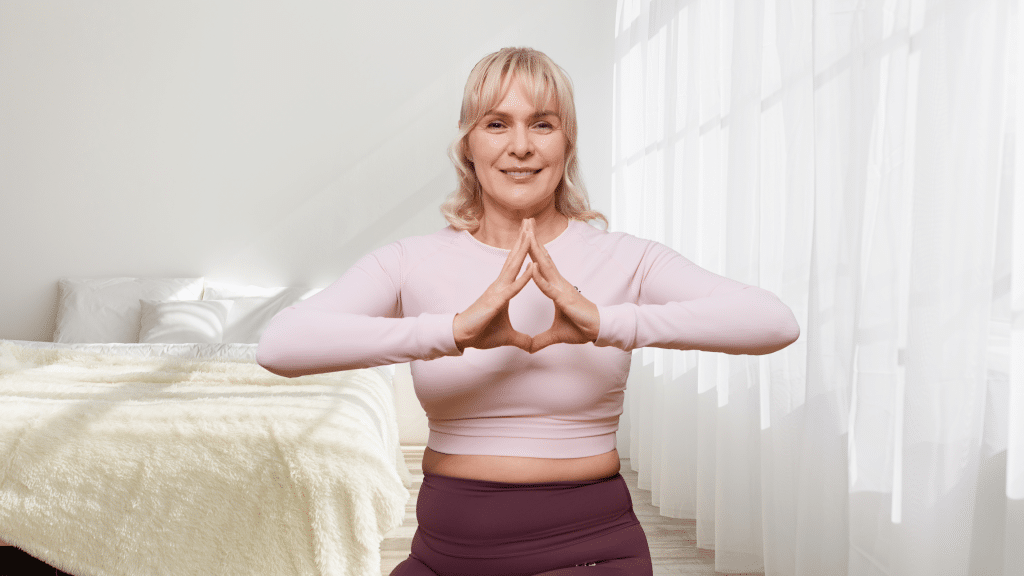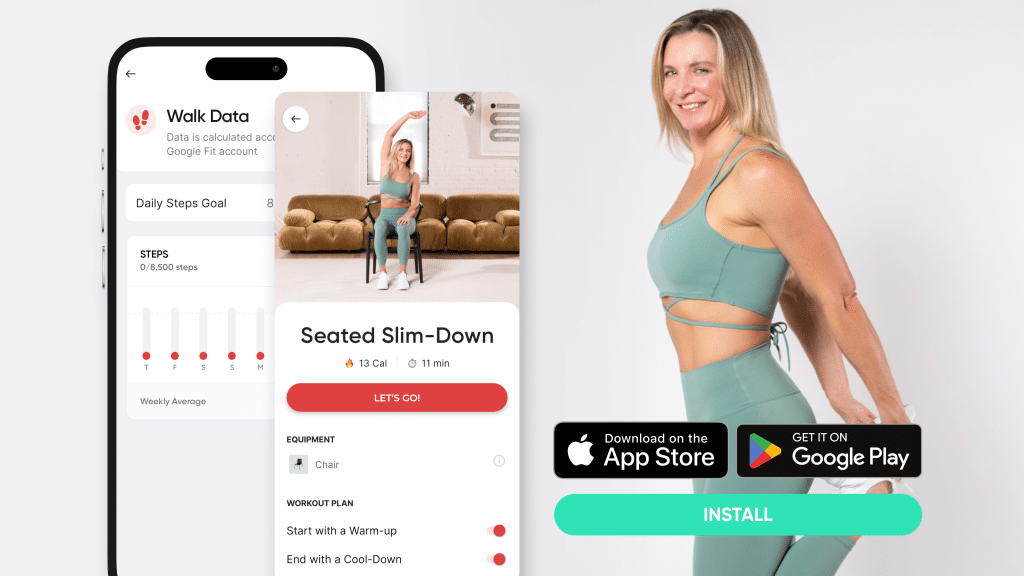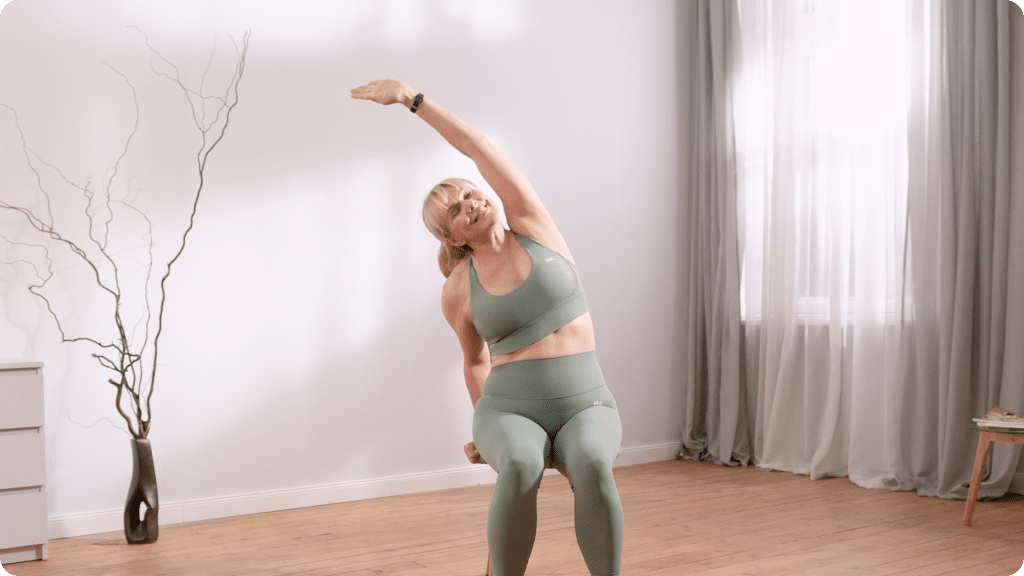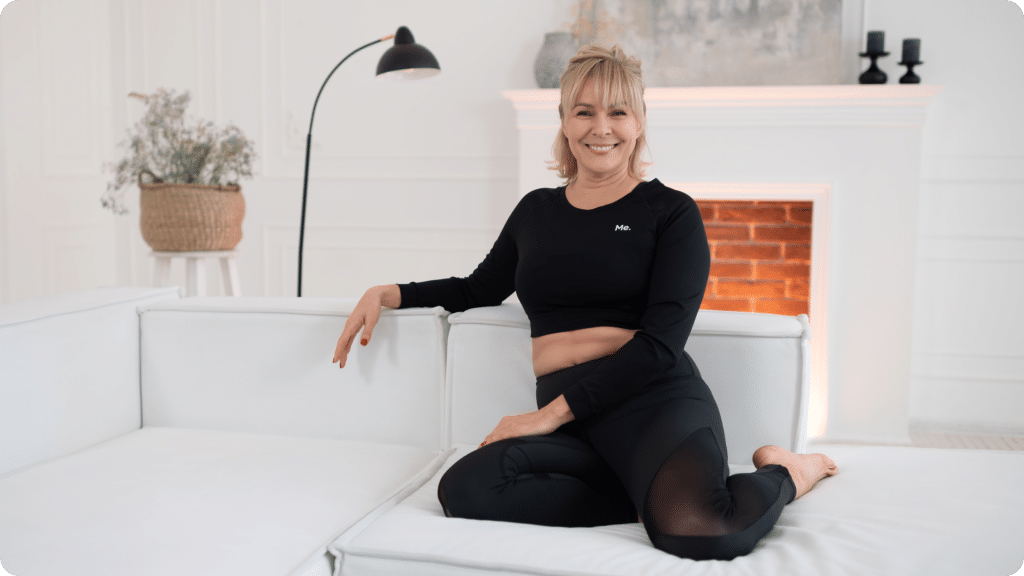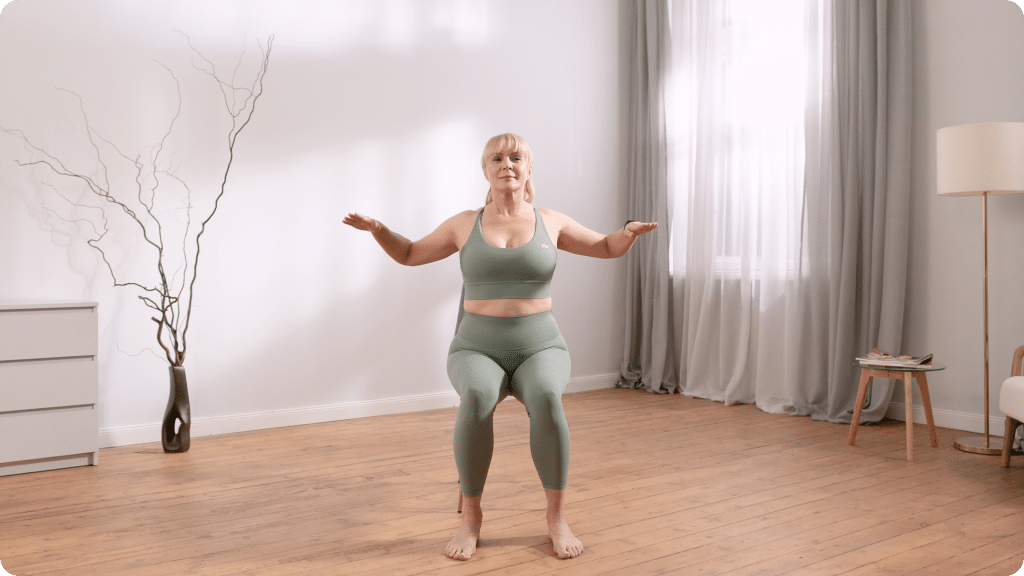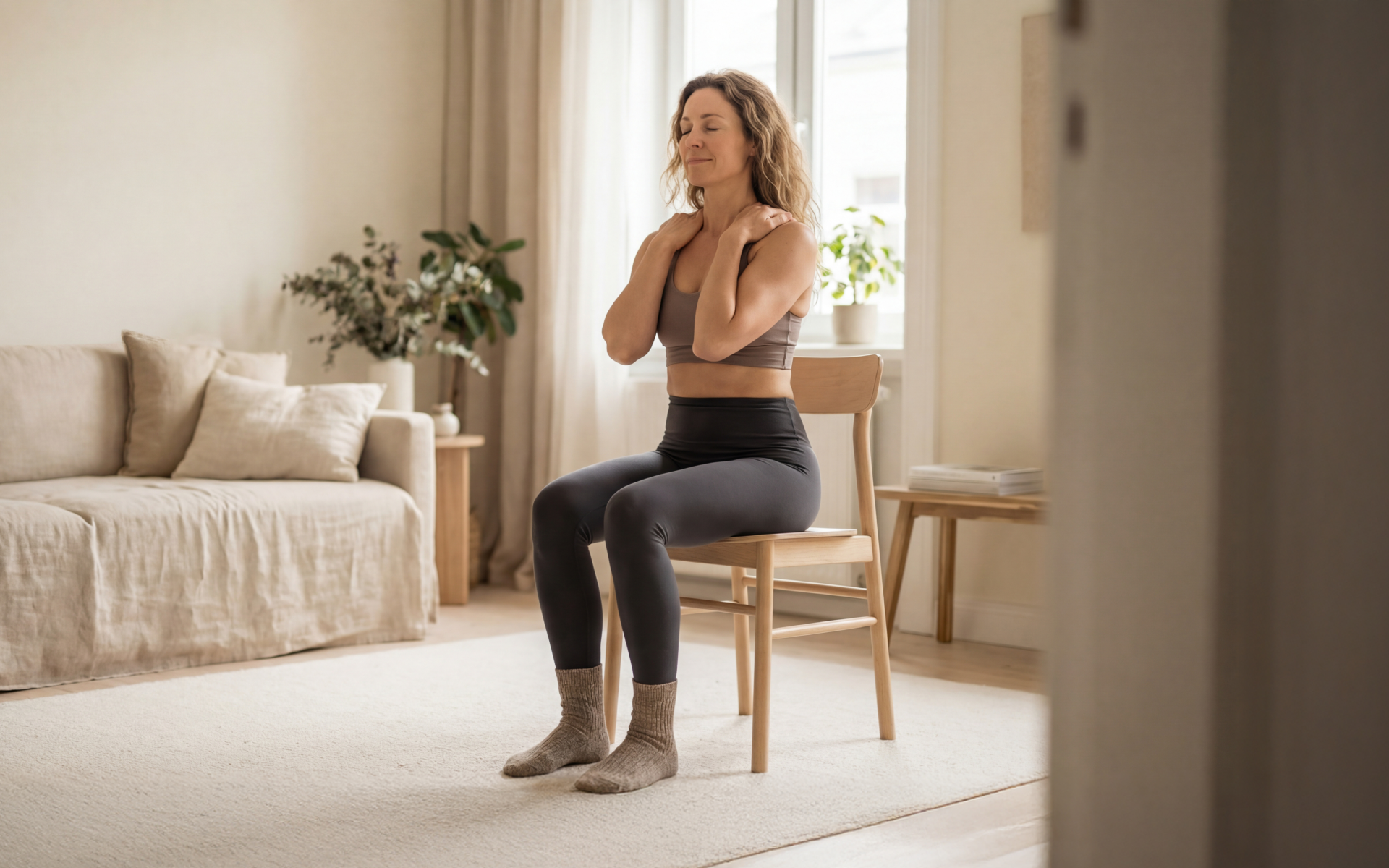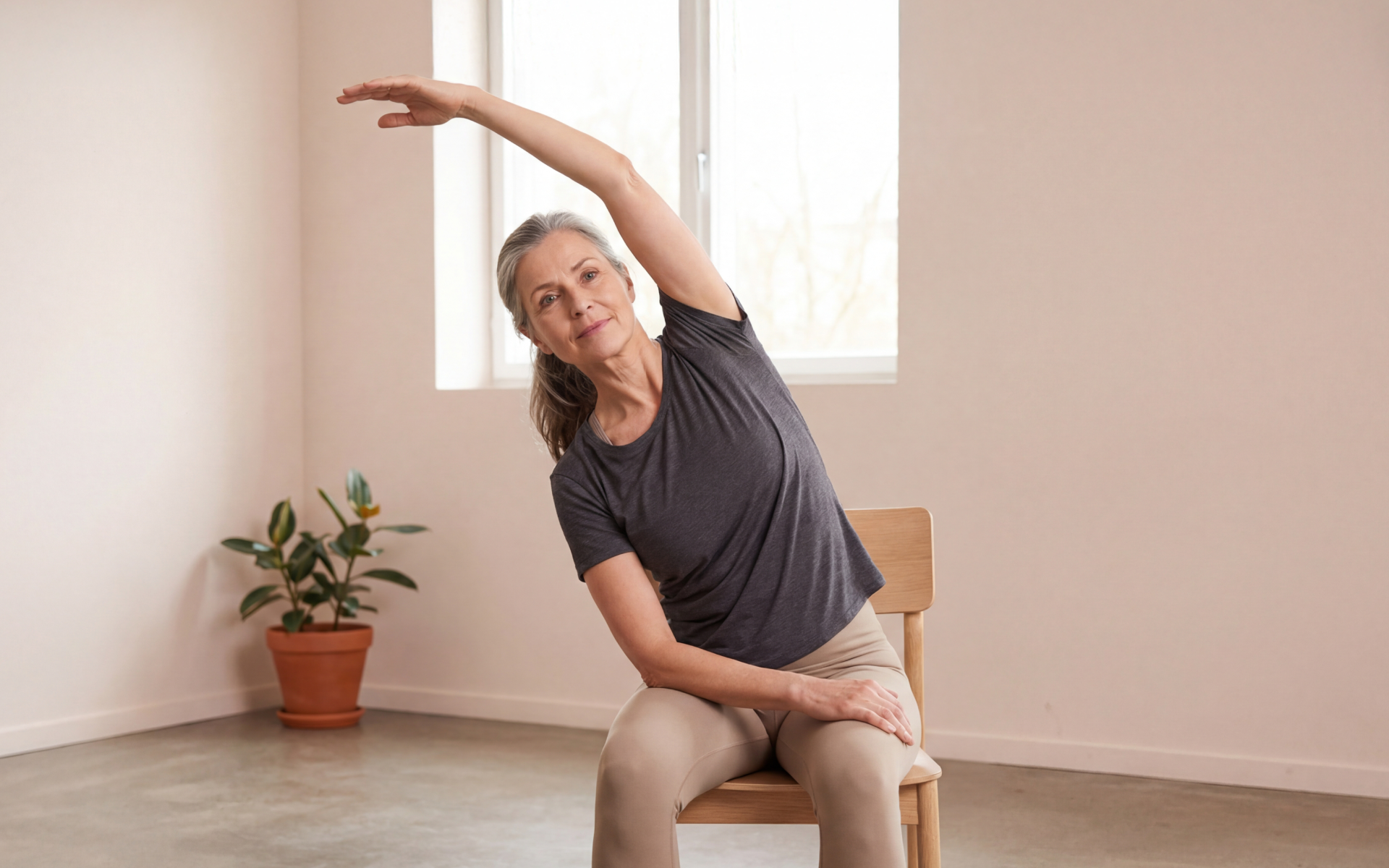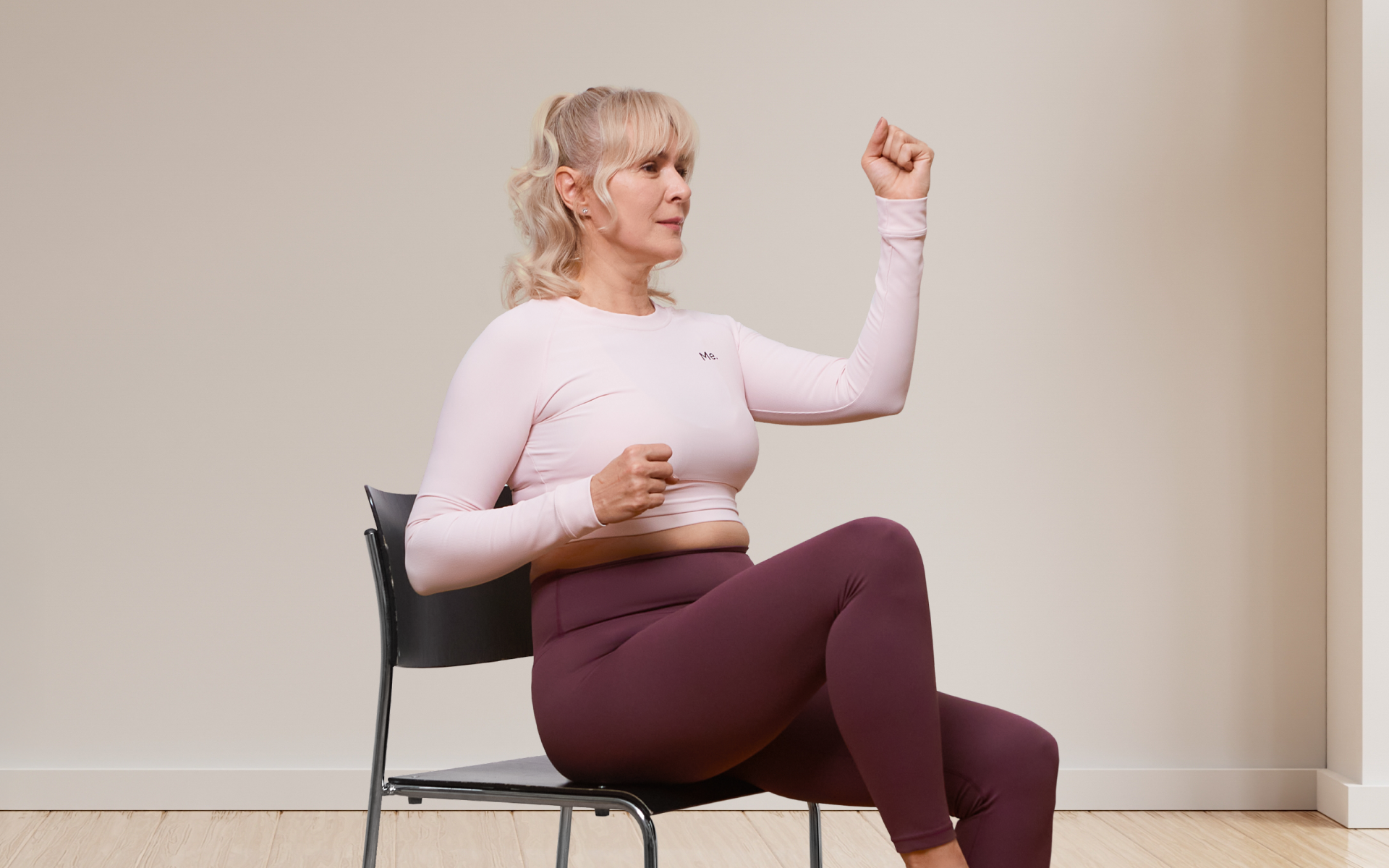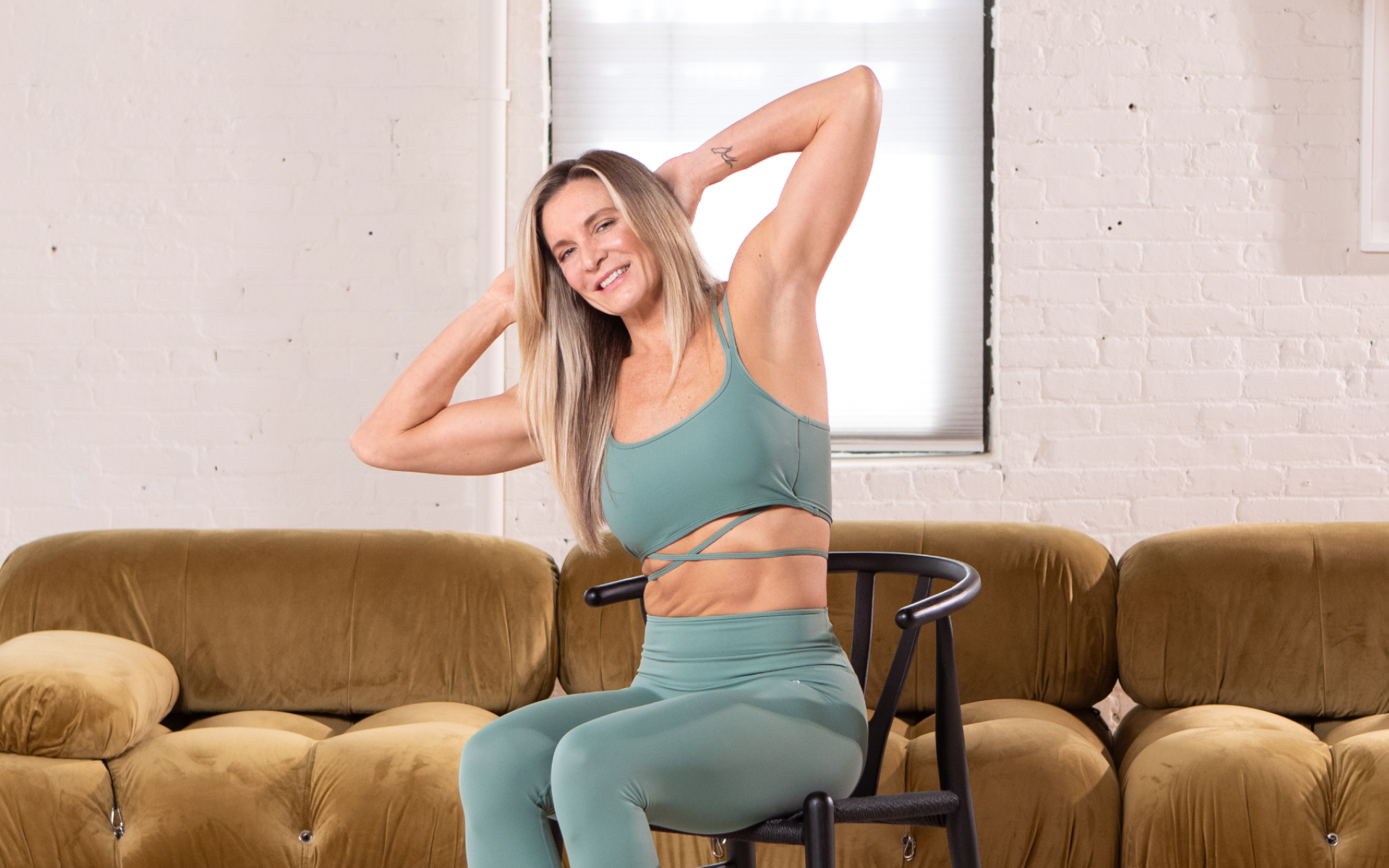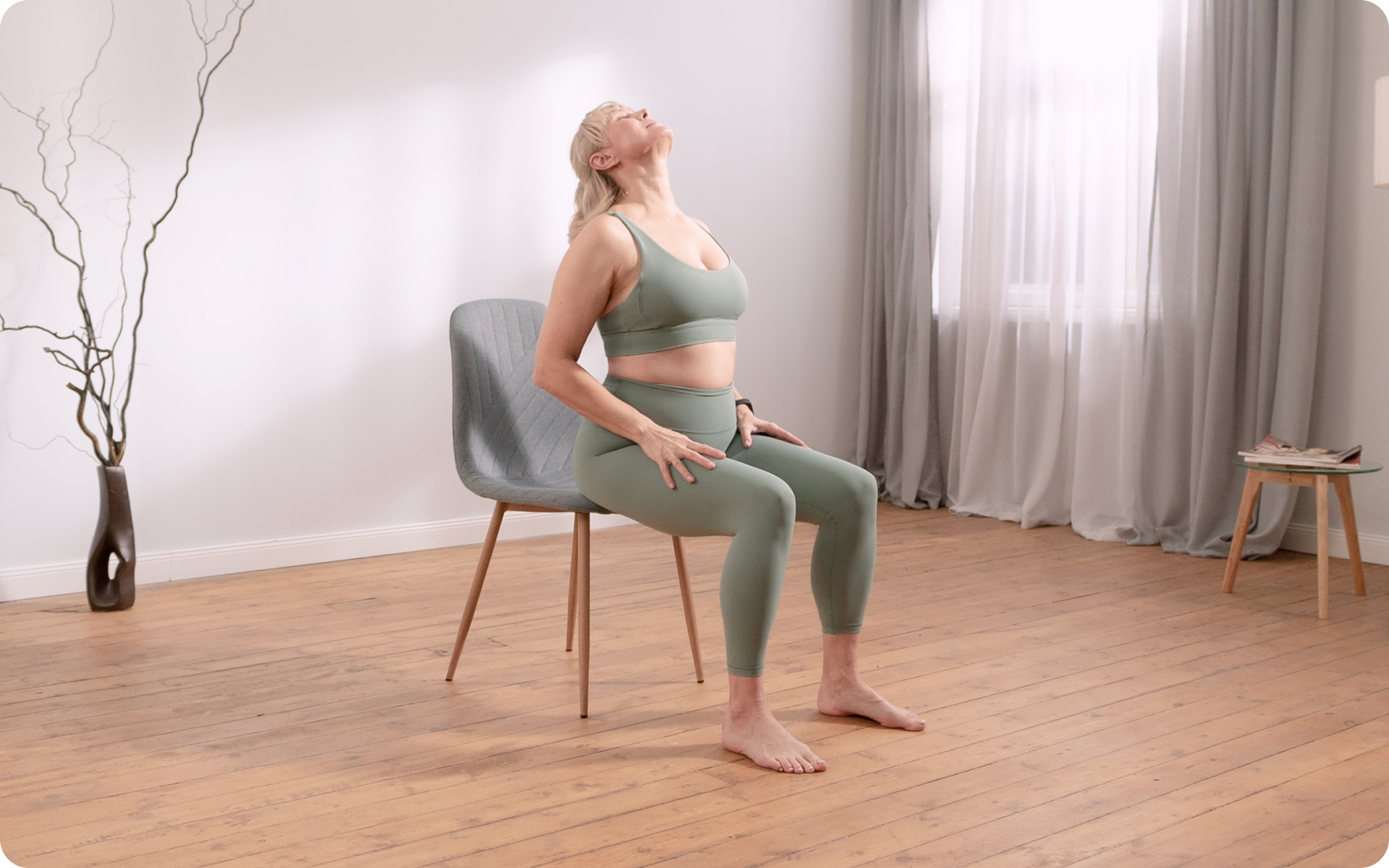Seated yoga is one of many adaptive forms of yoga that can be done at home. In this article, we’ll explore 8 seated yoga poses that are perfect for beginners to try at home. We’ll also discuss the benefits of practicing seated yoga and how you can incorporate it into your daily routine.
It’s a great way for beginners to start their yoga journey as it allows them to focus on their breathing and movements in a comfortable seated position. It’s also a great option for those who have limited mobility or injuries that make traditional standing poses difficult.
What Are Some Seated Yoga Poses for Beginners?
Some seated yoga poses for beginners:
- Easy pose (Sukhasana)
- Seated forward bend (Paschimottanasana)
- Bound angle pose (Baddha Konasana)
- Seated cat-cow stretch
- Seated spinal twist (Ardha Matsyendrasana)
- Wide-angle seated forward bend (Upavistha Konasana)
- Staff pose (Dandasana)
- Seated side bend
Easy Pose (Sukhasana)
Sukhasana, or easy pose, is a basic seated yoga pose that provides a great foundation for many other poses. To do this pose:
- Sit on the floor with your legs crossed and your feet resting comfortably on the opposite thighs.
- Keep your spine straight and place your hands on your knees or in your lap.
- Close your eyes and focus on deep breathing, allowing yourself to relax into the pose.
Benefits: This pose helps improve postural control, stretches the hips and back, and promotes relaxation and mindfulness.
Seated Forward Bend (Paschimottanasana)
Paschimottanasana is a seated forward bend that stretches the entire back of the body. To do this pose:
- Sit on the floor with your legs extended straight in front of you.
- Inhale and reach your arms up toward the ceiling.
- Exhale and fold forward, reaching for your toes or shins.
- Keep your back straight and lengthen through your spine as you hold the pose.
Benefits: This pose helps improve flexibility in the spine, hamstrings, and calves, while also calming the mind and relieving stress and fatigue.
Bound Angle Pose (Baddha Konasana)
Baddha Konasana, which is also known as bound angle pose or butterfly pose, is one of the seated yoga poses that stretch the hips and groin area. To do this pose:
- Sit on the floor with your legs extended straight in front of you.
- Bend your knees and bring the soles of your feet together, allowing your knees to fall out toward the sides.
- Hold onto your feet or ankles, keeping your back straight and lengthening through the spine.
Benefits: This pose helps improve flexibility in the hips and groin area, relieves tension in the lower back, and stimulates abdominal organs.
Seated Cat-Cow Stretch
The seated version of cat-cow is a gentle way to stretch and mobilize the spine while sitting. To do this pose:
- Sit on the edge of a chair with both feet flat on the ground.
- Place your hands on your knees and inhale, arching your back and looking up toward the ceiling (cow pose).
- Exhale and round your spine, dropping your head toward your chest (cat pose).
- Continue to flow between these two poses with each breath.
Benefits: This pose helps improve spinal flexibility, stretches the back and neck muscles, and promotes relaxation.
Seated Spinal Twist (Ardha Matsyendrasana)
The seated spinal twist is a great pose for improving mobility in the spine and stretching the hips. To do this pose:
- Sit cross-legged on the floor or on a chair.
- Place one hand behind you and the other on the opposite knee.
- Inhale and lengthen your spine.
- Exhale and twist toward the back, using your hand on your knee to deepen the stretch.
- Hold for a few breaths and then repeat on the other side.
Benefits: This pose helps improve spinal mobility, stretches the hips and shoulders, and helps with digestion.
Read more: Chair Yoga for Seniors — What’s It Really Like?
Wide-Angle Seated Forward Bend (Upavistha Konasana)
Upavistha Konasana is a seated forward bend that opens up the inner thighs and hamstrings. To do this pose:
- Sit on the floor with your legs extended wide apart in a V shape.
- Inhale and lift your arms up toward the ceiling.
- Exhale and fold forward, reaching for your toes or shins.
- Keep your back straight and lengthen through your spine as you hold the pose.
Benefits: This pose stretches the inner thighs, hamstrings, and lower back while improving postural control and calming the mind.
Staff Pose (Dandasana)
Dandasana, which is also known as staff pose, is one of the foundational seated yoga poses for beginners that helps improve postural stability and strengthen the core. To do this pose:
- Sit on the floor with both legs extended straight in front of you.
- Place your hands on either side of your hips with your fingers pointing toward your feet.
- Press your palms into the ground and lift through the spine, keeping your shoulders relaxed.
Benefits: This pose helps improve postural stability, strengthens the core and back muscles, and promotes concentration and balance.
BetterMe will shake off your mental funk, rid you of your energy-zapping habits, and help you sculpt the body of your dreams. Intrigued? Hurry up and change your life for the better!
Seated Side Bend
The seated side bend is a gentle stretch for the sides of the body that can be done anywhere with minimal space. To do this pose:
- Sit on a chair or on the floor with your legs extended straight in front of you.
- Reach one arm up toward the ceiling and then gently bend to one side, feeling a stretch along the opposite side of your body.
- Hold for a few breaths and then repeat on the other side.
Benefits: This pose helps improve spinal flexibility, stretches the sides of the body, and can relieve tension in the neck and shoulders.
Which Seated Yoga Poses Are Best for Beginners?
There are many poses that are great for beginners and it ultimately depends on your individual needs and goals. Some poses focus more on stretching and flexibility, while others focus on building strength and balance. It’s important to listen to your body and choose poses that feel comfortable for you.
That being said, some of the best poses for beginners include seated poses such as easy pose (Sukhasana) and bound angle pose (Baddha Konasana), in addition to standing poses such as mountain pose (Tadasana) and tree pose (Vrikshasana). These poses can help increase flexibility and promote relaxation.
Are Seated Yoga Poses Good for Beginners?
Seated yoga is good for beginners as:
1. It’s Accessible
Seated yoga poses can be done on a chair, which makes it accessible for individuals with limited mobility or those who experience discomfort when getting down on the floor. This makes it a great option for beginners who may feel intimidated by more advanced poses.
2. It’s Gentle
Seated yoga is generally gentle and low-impact, which makes it suitable for beginners or individuals who are recovering from injuries. The poses can be easily modified to suit individual needs and abilities (1).
3. It Promotes Mindfulness
Being seated and focusing on the breath in each pose allows for a greater sense of mindfulness and relaxation, which makes it beneficial for both physical and mental well-being (2).
Read more: Chair Yoga to Lose Belly Fat | Ab Exercises That Work
4. It Builds Strength and Flexibility
While seated yoga may not seem as physically demanding as other forms of yoga, it still helps improve strength and flexibility in the body (1). As beginners become more comfortable with seated poses, they can gradually progress to more challenging poses.
5. It Can Be Done Anywhere
One of the great things about seated yoga is it can be done anywhere – at home, in the office, or even while traveling. This makes it easy for beginners to incorporate into their daily routines.
How to Do Seated Chair Yoga Poses as a Beginner
Here are some tips for beginners to try chair yoga poses:
- Start with a comfortable and sturdy chair that allows your feet to touch the ground.
- Sit with your back straight and relaxed, keeping your feet flat on the ground.
- Begin by focusing on your breath, taking slow and deep inhales and exhales.
- Move mindfully into each pose, never forcing or straining your body.
- Use props such as blocks or pillows to modify poses if needed.
- Listen to your body and take breaks when necessary.
- Gradually increase the duration and intensity of poses as you become more comfortable and confident in them.
- Remember to always end your practice with a few moments of relaxation and deep breathing.
FAQs
Should beginners do yoga every day?
Beginners can practice yoga every day, but it’s important to listen to your body and not overdo it. Start with shorter sessions and gradually increase the duration as you become more comfortable. Consistent practice, even if it’s only a few times a week, can lead to significant benefits.
Try this Chair Yoga For Hips for a beginner-friendly lower-body workout.
Why can’t I do a yoga sit?
Difficulty with yoga sitting poses can be due to tight muscles, particularly in the hips and lower back, or limited flexibility. It’s important to practice regularly and incorporate stretches that target these areas. Using props such as yoga blocks or cushions can also help provide support and improve comfort.
How do I do chair yoga poses?
Chair yoga poses are performed while seated on a chair and are accessible to everyone, including those with mobility issues. To do a basic chair yoga pose, sit up straight with your feet flat on the floor and your hands resting on your knees. Focus on your breath and gentle movements, such as lifting your arms or twisting your torso.
These Seated Yoga Stretches may be what you need to help your mobility.
How do I sit straight in yoga?
To sit straight in yoga, start by sitting on the floor with your legs crossed or extended. Engage your core muscles to support your spine, and envision a string pulling the top of your head toward the ceiling. Keep your shoulders relaxed and your chin parallel to the floor. Sit on a folded blanket or cushion to elevate your hips and ease the posture if necessary.
What are the benefits of seated yoga poses for beginners?
Some benefits of seated yoga poses for beginners include increased flexibility and strength, improved postural control, and reduced stress and tension (1). Seated yoga is also a great way to introduce mindfulness into your practice and can be done anywhere with minimal space. It also provides a gentle form of exercise for those who are recovering from injuries or with limited mobility.
Conclusion
Seated yoga is a great way for beginners to ease into a yoga practice and experience its many benefits. For those with limited mobility or conditions that make traditional yoga poses difficult, chair yoga provides a gentle and accessible option.
Remember to always listen to your body and modify poses as needed. With consistent practice, you may find yourself progressing to more challenging poses and experiencing the full mind-body benefits of yoga.
DISCLAIMER:
This article is intended for general informational purposes only and does not serve to address individual circumstances. It is not a substitute for professional advice or help and should not be relied on for making any kind of decision-making. Any action taken as a direct or indirect result of the information in this article is entirely at your own risk and is your sole responsibility.
BetterMe, its content staff, and its medical advisors accept no responsibility for inaccuracies, errors, misstatements, inconsistencies, or omissions and specifically disclaim any liability, loss or risk, personal, professional or otherwise, which may be incurred as a consequence, directly or indirectly, of the use and/or application of any content.
You should always seek the advice of your physician or other qualified health provider with any questions you may have regarding a medical condition or your specific situation. Never disregard professional medical advice or delay seeking it because of BetterMe content. If you suspect or think you may have a medical emergency, call your doctor.
SOURCES:
- What Is Chair Yoga & What Are Its Benefits (2024, ymcawhittier.org)
- Fifteen Minutes of Chair-Based Yoga Postures or Guided Meditation Performed in the Office Can Elicit a Relaxation Response (2012, nih.gov)

